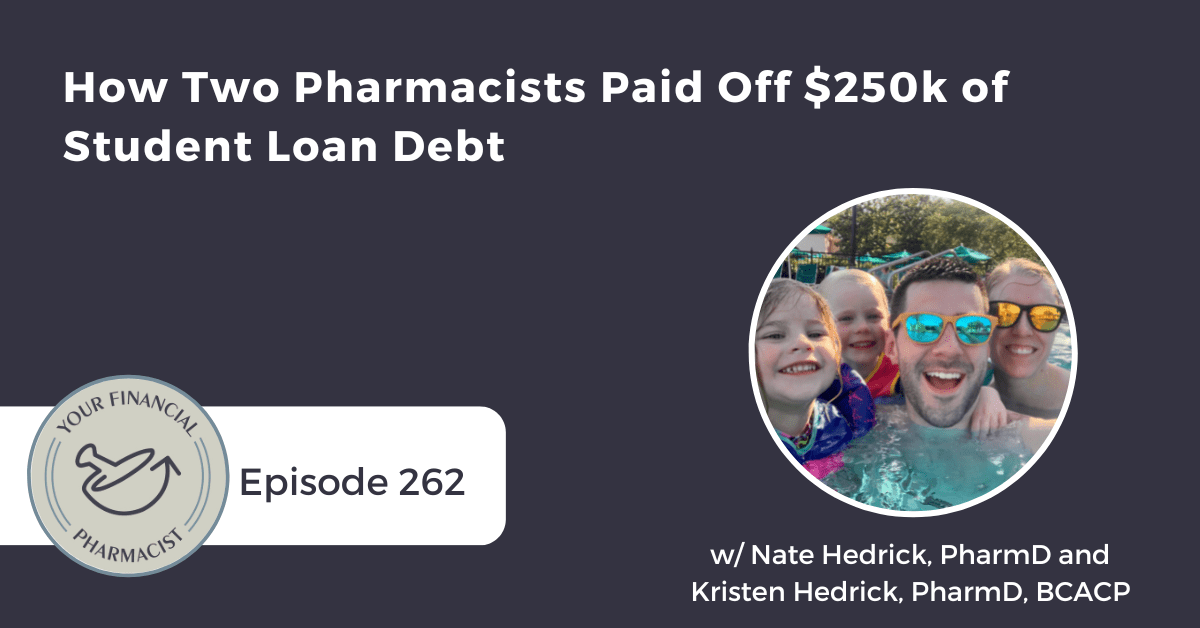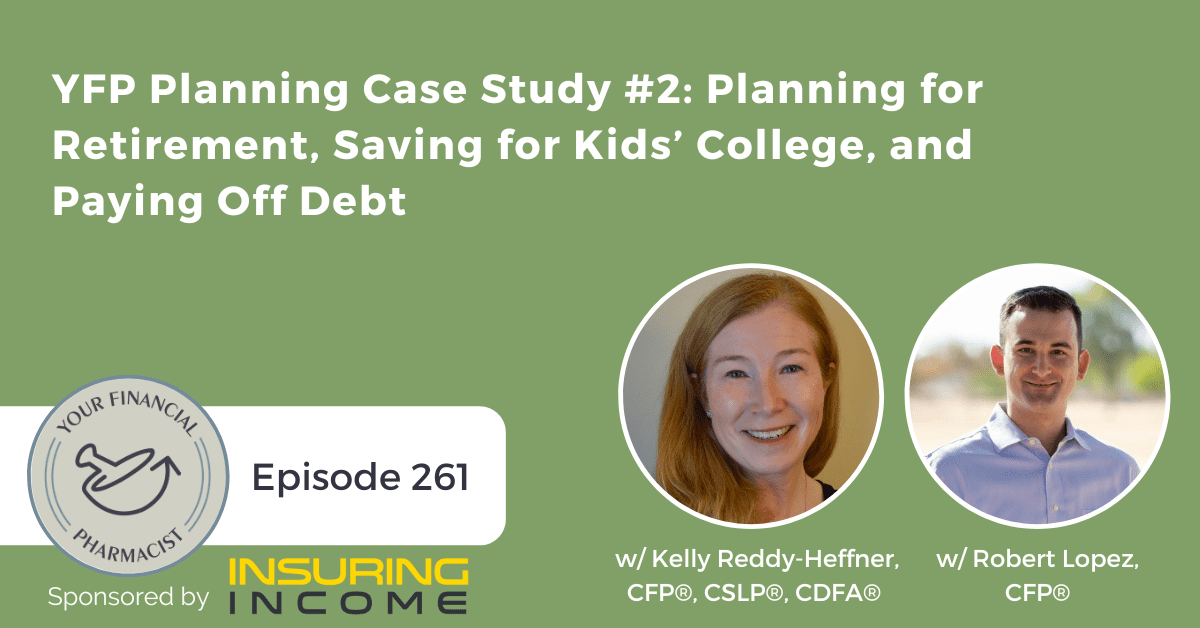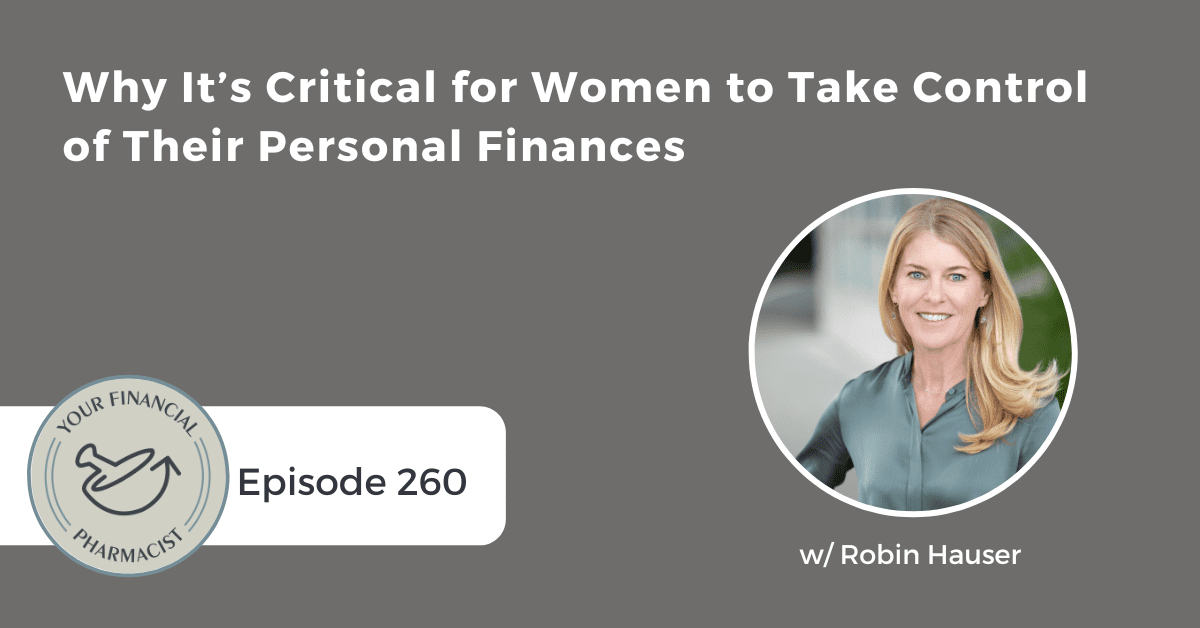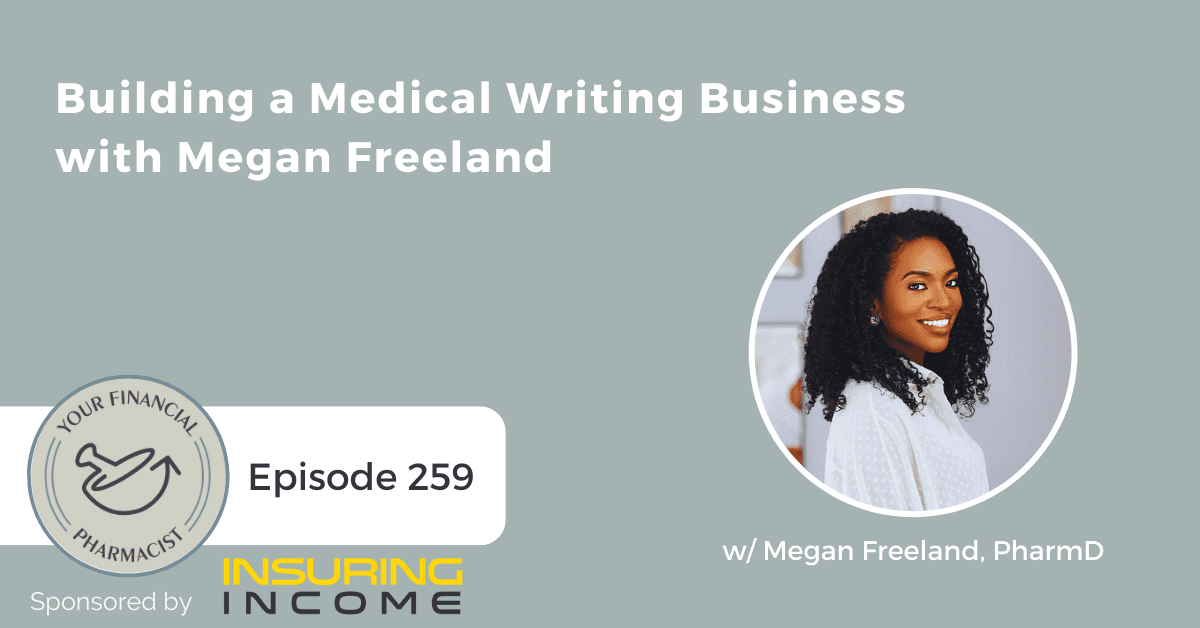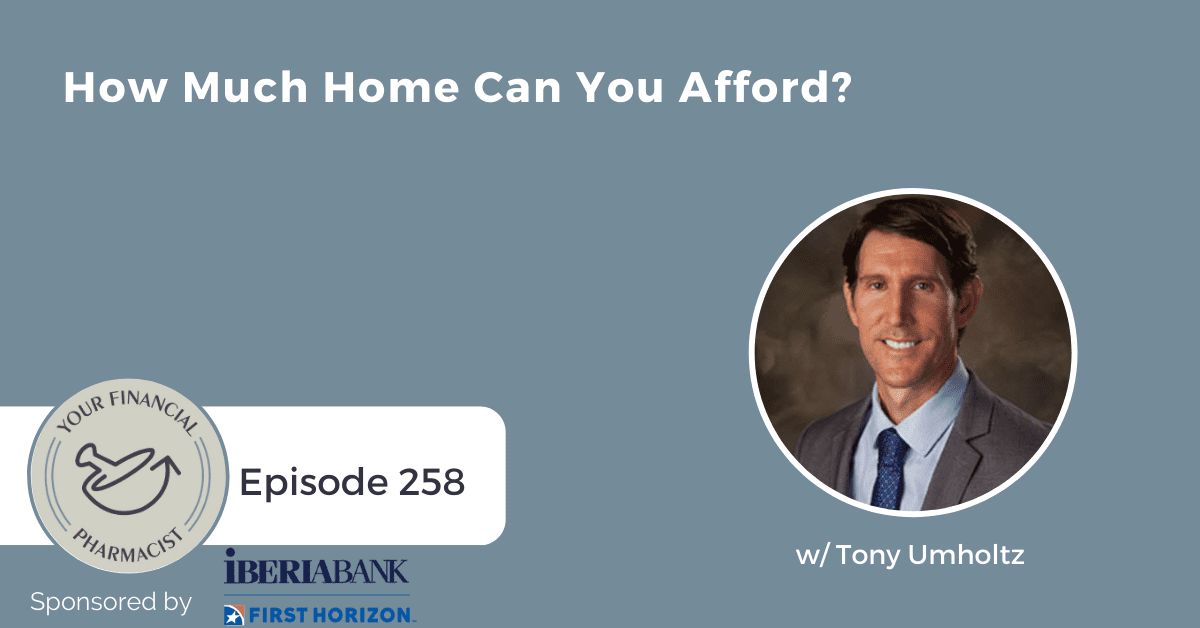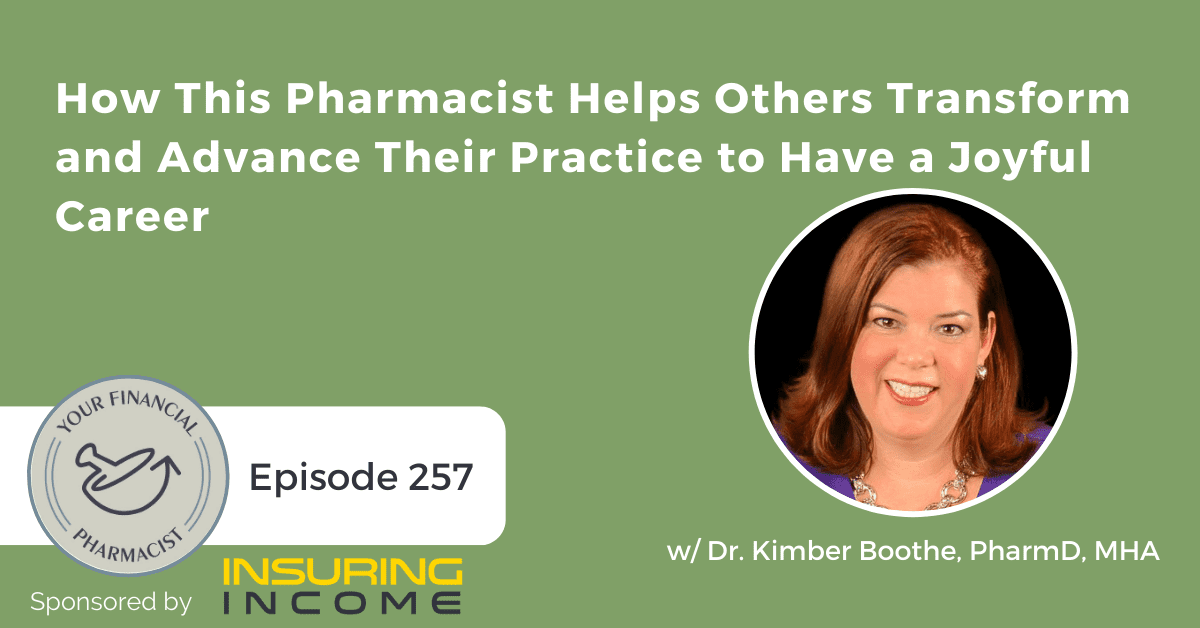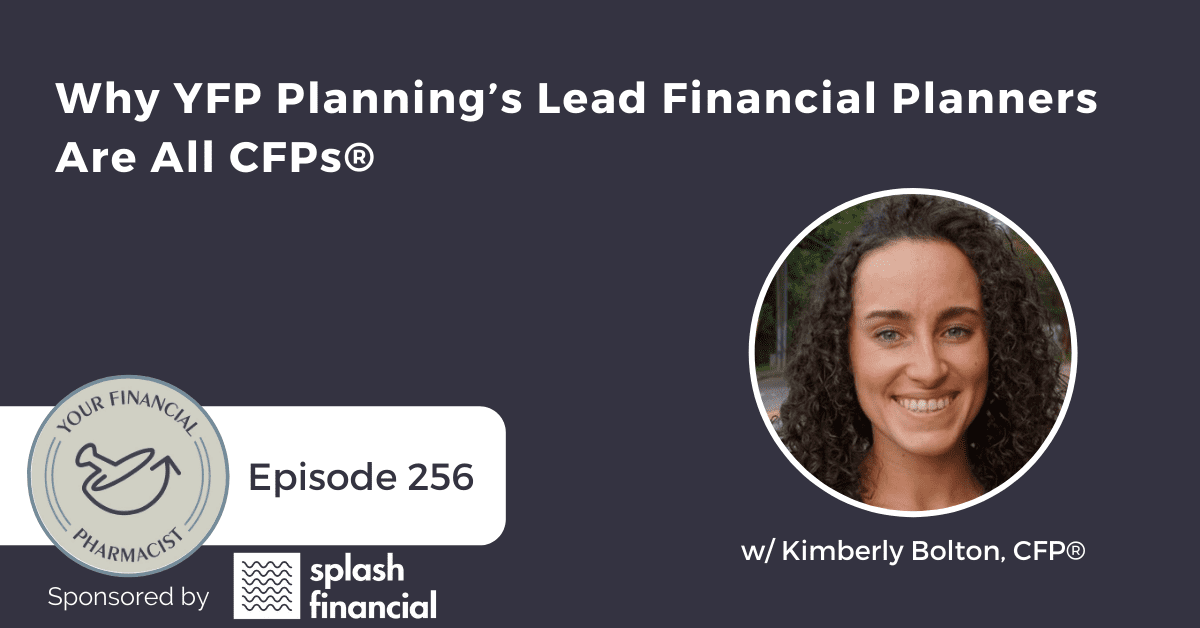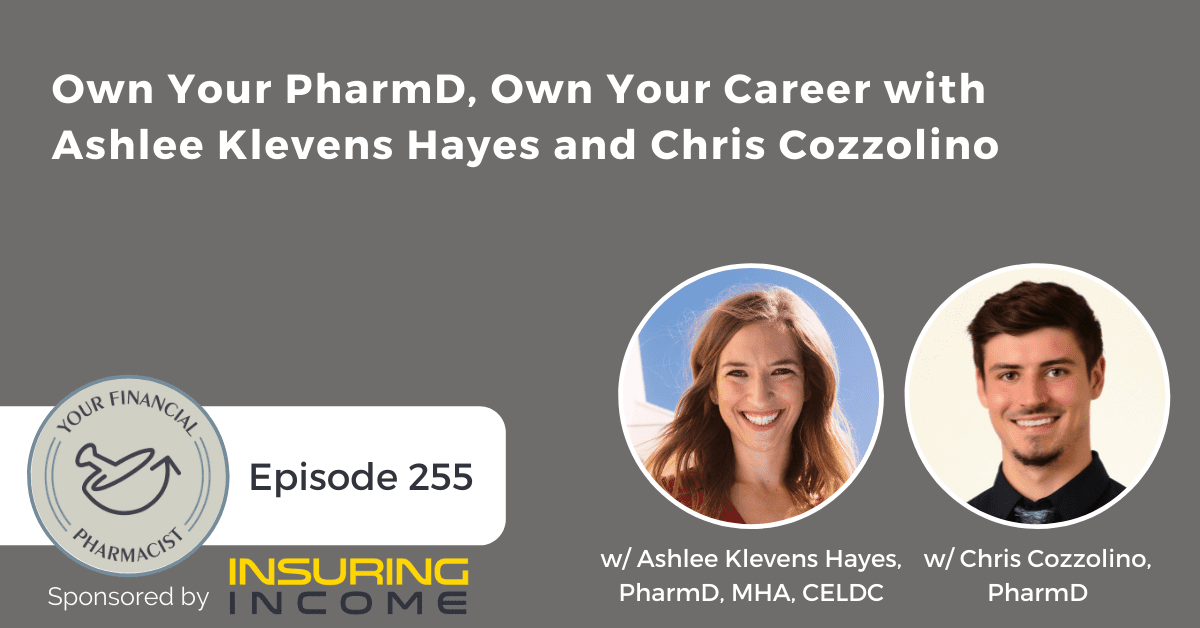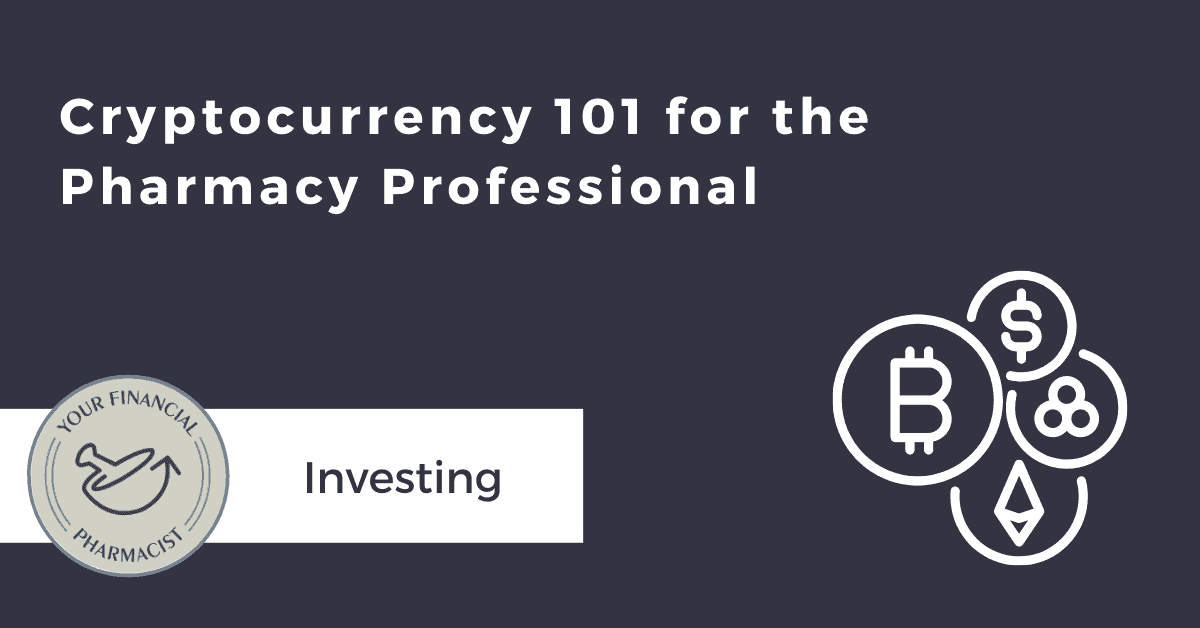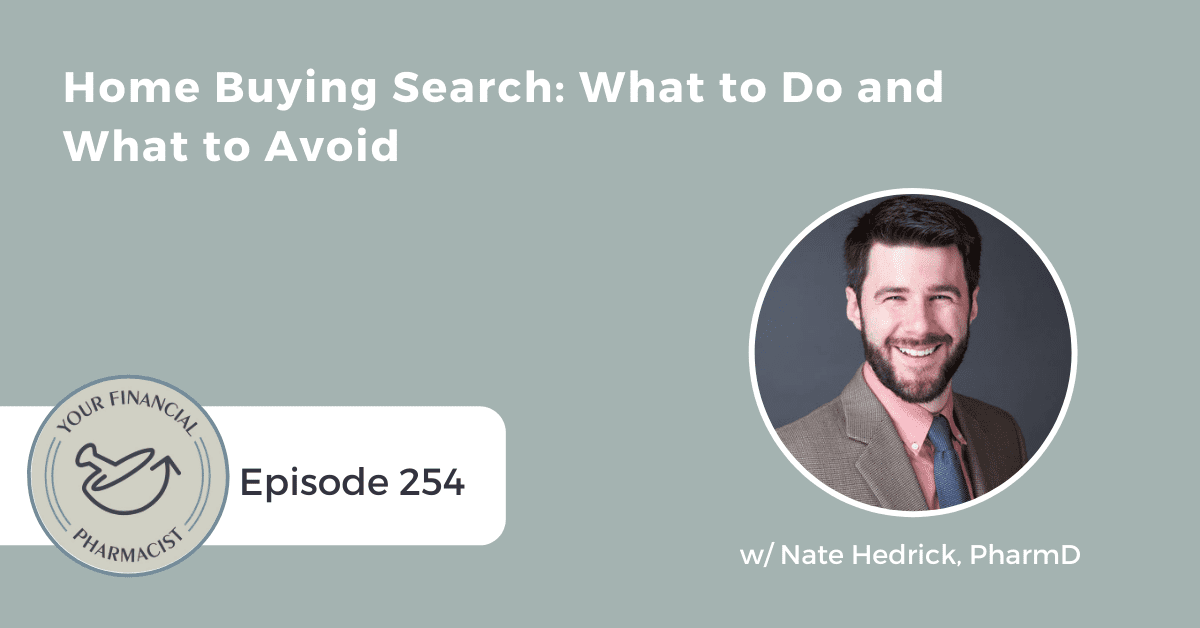How Two Pharmacists Paid Off $250k of Student Loan Debt
Kristen & Nate Hedrick to discuss their journey in paying off $250k of student loan debt, their motivation and why for aggressively paying off the debt, and the role a side hustle and real estate investing played to help them achieve their goal.
About Today’s Guests
Nate and Kristen Hedrick met at Ohio Northern University and were married in 2013. Nate is a pharmacist with Medical Mutual and a real estate agent with Berkshire Hathaway. Kristen is a pharmacist with Bon Secour Mercy Health. Together, they graduated with over $300,000+ in student loan debt. They enjoy visiting National Parks as a family. Today they live in the suburbs of Cleveland, Ohio, with their two daughters, Molly and Lucy, and their rescue dog Lexi.
Episode Summary
How do you go about aggressively paying off a $250,000 student loan debt without feeling overwhelmed? To help answer that question, YFP Co-Founder & CEO, Tim Ulbrich, PharmD, is joined by fellow pharmacists Nate Hedrick, PharmD, and Kristen Hedrick, PharmD, BCACP. The Hedricks tell us how they successfully paid off over $250,000 in student loan debt, their motivation for tackling that debt, the pivotal moment that sparked making repayment a priority, and the role a side hustle and real estate investing played in their journey. After a brief history of Kristen’s background, listeners will hear what motivated the couple to take an aggressive stance on their debt repayments, how a life-changing event and one book altered their financial philosophy, and how the pandemic helped them focus on their strategy. Nate and Kristen share their reasons behind paying their debt off now instead of putting their money toward investments and how they found an additional $3,443 per month to make their goal attainable by reducing expenses and increasing their income. This earnest conversation takes us through the possibilities of working full time, raising a family, making investments, and paying off a huge debt, all at the same time. Nate and Kristen talk about their life after paying off this debt and share some advice for pharmacists who may be struggling with a similar debt situation.
Key Points From This Episode
- Kristen’s background, how she ended up in pharmacy, and what she’s doing now.
- What their student loan debt looked like at its peak.
- How student debt can creep up and surprise you.
- The initial feelings the couple had towards their debt and their plans to pay it off.
- What motivated our guests to come up with an aggressive plan for paying back their debt.
- How a life-changing event (and a book) in 2016 changed everything.
- The global pandemic as a moment of inspiration.
- What they had to change in their lives to be able to make the monthly repayments.
- Paying off debt now versus investing for the future.
- The way the couple used ‘double motivation’ to reconcile an age-old debate.
- How our guests were able to raise a child, invest, and pay off a huge debt at the same time.
- Nate’s decision to pursue real estate investing and what that meant for their debt repayments.
- The approach the couple has taken to make real estate investing work for their family.
- Other strategies that helped to pay off the debt aside from cutting expenses and real estate investments.
- The benefits of receiving objective, third-party advice.
- What life is like now after paying off their massive debt.
- How paying off the debt helped Nate make an important career decision.
- Kristen’s advice for the pharmacist struggling with debt.
- Nate’s parting words of wisdom.
Highlights
“That was the worst that it got and, that same month, for what it’s worth, we had a negative net worth of $306,000. We had about 10k to our name and a bunch of debt to add on to that.” — Nate Hedrick, PharmD [0:03:44]
“I had no plan early on until we developed the ‘why’, which was getting our financial house in order so that we could live the way that we wanted to.” — Nate Hedrick, PharmD [0:06:23]
“The expenses were the catalyst, and then it was the extra income side of the equation that really boosted everything to actually make it possible.” — Nate Hedrick, PharmD [0:13:37]
“Spending more time with the kids without having that student loan debt, and being able to do more things and travel more, it feels like it’s definitely paying off in the end, with making some of those sacrifices.” — Kristen Hedrick, PharmD, BCACP [0:17:16]
“One great thing about real estate investing is even if something happens, you still own a building.” — Kristen Hedrick, PharmD, BCACP [0:22:00]
“Find something that is going to supplement your life that the more effort you put into it, the more reward you get out of it. That is a really great way to set yourself up for success.” — Nate Hedrick, PharmD [0:29:32]
Links Mentioned in Today’s Episode
- YFP Planning: Financial Planning for Pharmacists
- Schedule a free Discovery Call with YFP Planning
- YFP Real Estate Investing Podcast
- Rich Dad Poor Dad: What the Rich Teach Their Kids About Money That the Poor and Middle Class Do Not! by Robert T. Kiyosaki
- Real Estate RPh
- YFP Real Estate Concierge Service
- BiggerPockets
- Your Financial Pharmacist Disclaimer and Disclosures
Episode Transcript
[INTRODUCTION]
[0:00:00.4] TU: Hey everybody, Tim Ulbrich here. Thank you for listening to The YFP Podcast, where each week, we strive to inspire and encourage you on your path towards achieving financial freedom.
This week, I had the pleasure of sitting down with Kristen and Nate Hedrick to discuss their journey of paying off $250,000 of student loan debt. In this show, we discuss their motivation and why, for aggressively paying down the debt. What the pivot moment was that motivated them to make the debt repayment a priority, how they were able to come up with more than $3,000 per month extra to throw towards the loans, and the role a side hustle and real estate investing played in helping them pay down the debt.
Before we jump into the show, I recognize that many listeners may not be aware of what the team at YFP Planning does in working one-on-one with more than 240 households in 40-plus states. YFP Planning offers free only, high-touch financial planning that is customized for the pharmacy professional.
If you’re interested in learning more about working one-on-one with a certified financial planner may help you achieve your financial goals, you can book a free discovery call at yfpplanning.com. Whether or not YFP Planning’s financial planning services are a good fit for you, know that we appreciate your support of this podcast and our mission to help pharmacists achieve financial freedom.
Okay, let’s jump into my interview with Nate and Kristen Hedrick to learn how and why they aggressively paid off $250,000 in student loan debt.
[INTERVIEW]
[0:01:23.4] TU: Kristen and Nate, welcomed to the show.
[0:01:24.7] NH: Hey Tim, good to be here.
[0:01:26.1] KH: Hi.
[0:01:27.0] TU: So Nate, obviously, you’re a frequent flyer. You’re old news so I’m not even going to spend a whole lot of time focusing on you. Many folks have heard you on the podcast before, whether it’s this show, talking about home buying, whether it’s the Real Estate Investing podcast on Saturday mornings, of course, Nate being the cohost of that show.
So, we’re going to focus a little bit more on Kristen’s background as we get started, and we’re going to jump into more about your debt-free journey and how ultimately, you guys were able to knock out $250,000 of debt, and what that has meant to you guys personally, to your family, as well as also the financial goals and plan that you have going forward.
So, before we jump into that debt payoff and that journey, Kristen, let’s start with you. Tell us a little bit more about your background, what drew you into pharmacy, where you went to school and the work that you’re doing now.
[0:02:13.0] KH: Yeah, thanks. I had some extended family members in pharmacy so I just thought it would be a good career path, and looked at the different pharmacy schools and found my way to Ohio Northern in the middle of cornfields, and no cellphone reception and for some reason, that’s where I wanted to go. I think we all know it’s a great campus and community there.
So went to Ohio Northern and that’s where Nate and I met. I completed my residency here in Cleveland, Ohio. Now I work for a large health system doing population health on clinical pharmacy, and following patients with their chronic disease states and helping them with their medicines, and helping in here in Cleveland.
[0:02:50.8] TU: Kristen, it’s funny you mentioned the cellphone reception in Ada Ohio, Ohio Northern University. I remember, I maybe as a P3, P4, just a few years ahead of you guys, but it was a big deal that they added a tower on campus, and I think we got one bar, maybe two bars, but not a whole lot going on in Ada Ohio. I had the chance to go back recently and take Jess and the boys. It was so fun to see campus and really relive some of the memories in that place.
So Nate, tell us about the student loan debt at its peak? What were you guys working with and then, from there, we’ll get into more of some of the motivation and journey of paying it off.
[0:03:26.4] NH: Yeah. So, when we graduated and totaled everything up and, I think it was even a month or two after we graduated that I even wanted to look at it. Because it was the initial plan of, “I just won’t look at it and then it won’t be a problem.” And when we totaled it all up, looking back at our highest count, we were at $316,000 in student loan debt at one point.
So, that was the worst that it got and, that same month, for what it’s worth, we had a negative net worth of $306,000, so we had about 10k to our name and a bunch of debt to add on to that.
[0:03:54.8] TU: I’m curious, did that surprise you guys? One of the stories I often share is that, it’s somewhat embarrassing, but when I was in pharmacy school, it felt a little bit like monopoly money, and it was all of a sudden when I crunch the numbers and I was like, “I owe how much, and how much interest, and what’s my net worth?” It just caught me off-guard, and it shouldn’t have. Were you expecting that or was that number somewhat a surprise at that point?
[0:04:15.4] NH: I agree, it was just totally like made up funds, you know? Every quarter or every semester, I’d have to go and submit for what I needed, and it was the tuition plus a little bit of living expenses, and I would just submit for it and it would get added into this imaginary pile of money somewhere, and I don’t think I ever checked the balance while I was in school, I don’t know why, I don’t know why I would have.
[0:04:35.7] TU: You’re dating yourself Nate, when you talk about quarters by the way. So that ain’t a thing anymore.
[0:04:40.7] NH: Old school, how I work.
[0:04:42.7] TU: Kristen, tell us about the plan that you guys had for the student loans after graduation, after you got married in 2013. How did you feel about the debt overall and then, what was the thought in that moment about how are you going to pay this off?
[0:04:55.7] KH: I think our main thought was it’s overwhelming. It’s just such a large amount that it feels so ambiguous that we thought that we had this plan. We had always wanted to try to pay it off within 10 years. I think I was a little more on track of, “Oh, I want to pay this off in 10 years” and we had some advice from a previous financial advisor that had said, “Oh, it’s just student loan debt, everyone has it, it will be okay.” We changed it to 30 years so we could have minimum payments but always pay extra if we wanted to and, ultimately, we just found that that eventually did not work as well for us.
We needed a more targeted plan to get us on track with what we were doing. We had always been paying the amounts, but I think it was how we were planning to target to actually pay it off. It always felt like this end date that we were never going to get to.
[0:05:44.4] TU: One of the questions I like to ask folks, and we’ll talk more in a little bit about how aggressive you guys were to really get a chunk of this paid off, but I like to understand, what’s the why? What’s the motivation behind it? It’s one of these things, as you mentioned, you can take them out 25, 30 years if you want to. Obviously, you guys made a good decision to be much more aggressive. Tell me more about for the two of you, for your family, why was that important?
[0:06:08.2] NH: It’s funny you say that because I think until I had a why, it wasn’t important. Like I said, I didn’t look at it, I barely wanted to check it. I think at one point in residency, I put myself on the graduated repayment plan and my only motivation was because the payment today is lower and that seems like—that seems better, right?
I had no plan early on, until we developed the ‘why’, which was getting our financial house in order so that we could live the way that we wanted to. Travel, work less, work in the capacities that we wanted to, all the things that have led us to this point. Until I had that in place, there wasn’t a why and it didn’t matter.
[0:06:42.7] TU: Yeah, I think that’s such a good encouragement for folks that are in the midst of their journey, or maybe have wondered into the repayment or for that matter, the financial plan at large, and feel like, “Hey, maybe I’m progressing but not as quickly as I would like to. I’m a little bit stuck.” Really going back to what gets us excited, right?
The topic of money, money is a tool. So, what gets us excited, why do we care bout this topic of money, why do we care about debt repayment, why do we care about saving/investing for the future, why do we care about giving? And then using that as the motivation to drive some of the action and the plan going forward.
So, Nate, what happened in 2016 that was really a motivation to say, “Hey, we’ve got to do something different?”
[0:07:22.0] NH: Yeah, that really is when it changed for us and, again, we’d been paying on them and, every once in a while, we get the idea that, “Hey, we should throw in some extra money because these loans are huge.” We would do it for a couple of months and I feel like we just were inconsistent. But in 2016, we got pregnant with our first child and, again, I tell this story on the podcast several times, but I read Rich Dad Poor Dad and it completely changed my mindset about money and what I wanted to do with money and what I wanted to do with my life and work, and just how I looked at finances.
It’s crazy it took that long to figure that out but I had no formal financial education. We go through pharmacy school, not business school, and until I read that book and changed how I wanted to approach finances in general, again, I didn’t have that why behind it. I didn’t have that motivation, so that’s what really jumpstarted us. I think it was a combination of, “Oh crap, we have a kid on the way and we have to pay for a lot of stuff” and again, this mindset shift that occurred, at least for me.
[0:08:16.1] TU: Kristen, I’m curious. I can just see Nate, because I know him now, I could see him like this totally nerding out over Rich Dad Poor Dad and coming to you with all these ideas and, “What about this, what about that?” Were you equally on fire in that moment or was there different motivations that really led you to say “Hey, we’ve got to do this differently?”
[0:08:34.4] KH: Yeah, I think I had always wanted to pay off the loan. Again, it was just so—it was a large amount that I think I didn’t know how to get there. When Nate said he read Rich Dad Poor Dad, he kept talking about it and talking about it. I think finally, in 2019, I read it, I said, “Oh, this is a really good book, I should have done it sooner”
So, I think we are a really good team together, in trying to work together and get those payments down, and Nate was very much more into it. I think at the time, I was like, I’m growing a human, I’m just going to keep doing what I’m doing, and that was the time that Nate entered real estate. He’s told this story before but, I’m six months pregnant and he goes, “Oh, I think I want to get my real estate license.” This is a time most people would have been getting board certified.
He’s like, “I’m going to go get my real estate license.” He had classes multiple times a week and I’m pregnant, trying to take care of the house and do all these things, getting ready for a baby. So, it paid off in the end and I’m glad that he did it, but I think in the moment there was also that stressful situation for me, but he’s a jack of all trades. He does lots of things and keeps busy, so it’s good.
[0:09:36.0] TU: We’re going to come back to that in a little bit, of what role did that play, Nate, for you, in terms of pursuing that, as you call, a side hustle. It’s much bigger than that, the work that you’re doing now, obviously, but why was that so instrumental, and not only to the numbers but also to some of the mindset and the motivation behind the financial plan and the journey that you were on?
I want to first talk about, though, Nate, walk us through what happened in the pandemic that really allowed you guys to say, “Hey, we’re going to get specific about when we’re going to payoff a big chunk of this debt, what it’s going to take each month.” Talk to us about what happened during the pandemic that led you to the decision around how you were going to pay off a huge portion of that debt.
[0:10:15.5] NH: Yeah, so, like I said, 2016 is where we started getting pretty serious, but even then, it wasn’t truly resolute plan, right? It was just, “Okay, we really got to be focusing on throwing extra money at this” and we did a lot better. But in 2020, we had a month or two in the pandemic and realized, “Okay, we’re not traveling as much, we’re not going to be going out to eat as much, everything shut down, let’s use this time to take the extra money that we’re not spending and really attack that loan.” At one point and, again, we were talking this morning, it was right at the end of the year, we said, “Okay, this thing is not going away, let’s really use next year to just get rid of this loan.”
So, right in December of 2020 and going into the beginning of the New Year, we said, “Let’s figure out a number. What is it that’s going to take to get this loan knocked out at the end of the year? Who cares of the balances right now, we’re going to do it in a year, let’s make sure to get it done.” So, we did some crunching of some numbers and basically said, “Okay, if we can pay everything we’re paying today but also throw an extra $3,443 at the loan every single month, mine will be gone by the end of the year and it will be just knocked out.”
So, that number, I wrote it on the big note card over here and it became like—actually got it here, I’ll grab it. Here you go, so there’s the evidence, right? 3,443. So, that became—I put that everywhere and it became the mantra of like, “If we can do that every single month, this will be gone” and that was such a huge motivator for us.
[0:11:32.8] TU: I don’t want to brush over that, because we’ll talk about it, I mean, that’s a big number, so we’re going to talk about the how of that, but tell us more about how you were able to get to that conclusion and get on the same page with that conclusion? What I’m specifically getting at here is, was it a, “hey budget status quo and we’re going to find ways to grow our income”? Was it a, “we’re going to cut some expenses”? How did you guys work through the details, Kristen, to ultimately say, “Yup, it’s $3,443 and this is how we’re going to do it.”
[0:12:04.5] KH: I think it was a little bit of a combination of both. During the pandemic, we had a little bit more interest. I think also, in doing some real estate investing and had an opportunity, we said, “Okay, do we take this money and do we put it towards real estate or do we pay down the loan more?” and eventually, we decide real estate, but we said, “Hey, like, maybe we should aggressively pay off our loan a little bit more if we are traveling and doing these things.”
So, I think in December, we had a lot of discussion about it and both of us just decided yes, we both want that to be our goal, that starting January 1st, we really start cutting back on what we’re spending. I think, really, from any area that we could, we went thorough our budget, we scrubbed it. We said, “What are we spending money on, what are the subscriptions we have, what can we cut out, what can we save money on?”
“Which of those little purchases can we just stop doing? Which things do we think that we need, can we actually hold off on buying?” and then, certainly, Nate’s side hustle helped with that as well. So, I think it was both a combination of, let’s cut back to really bare minimum spending. We weren’t eating out, we weren’t getting the extra cups of coffee from Starbucks, we weren’t doing the purchases at Target that said, “This is what you need, and this is in the dollar spot.” We just stopped all of that. And Nate worked as hard as he could with his real estate; it really is a motivator to keep putting that extra money towards it as well.
[0:13:22.3] NH: Yeah, I think we quickly realized that trying to find for an extra $3,000 in the budget. We weren’t over spending by three grand every month, that was not it, so it became my challenge to say, “Okay, well, how can I work at this side hustle to really get us the rest of the way?” So, the expenses were the catalyst, and then it was the extra income side of the equation that really boosted everything to actually make it possible.
[0:13:44.7] TU: Yeah. What I love about that is, certainly, cutting expenses, especially short-term, if you’re focused on a goal, you were talking about debt repayment, can be really valuable but it also can be a grind. I mean, it can be soul sucking sometimes, you know?
I think that one of the things I love about the approach that you took is that if you’re moving both sides of the equation, there’s a different level of momentum and mindset that come from that. Maybe the numbers aren’t as big for other folks that are pursuing ideas, but if you can both focus on, “Hey, how can we draw the income and how can we keep the expenses?” you all of a sudden feel like you’re picking up momentum in a significant way, but I don’t want to brush over that number.
$3,443 per month, that’s, for many pharmacist, if we assume, hundred, $120,000 of wage, it’s like, it’s about half of take home pay. I mean, for a lot of folks, we look at that at a monthly basis so that’s certainly commendable, and that’s a big number. Nate, I want to ask the question that I know the listeners are thinking, which is Nate, Kristen, you guys are smart. $3,443, why not invest that money?
Why not put that out so we could see that grow and compound over 20, 30, 40 years? Like, how did you guys reconcile this ongoing debate, which is maybe a little bit of a moot point right now because the administrative forbearance, but this ongoing debate of, “Should I pay down the debt or should I invest for the future?”
[0:15:03.9] NH: Yeah. This is something we struggled with for years. Should we go out and buy another rental property or should we just take this money and throw it at the loan? That’s been the back and forth. Like Kristen was saying, we were evaluating whether we should be doing real estate or paying down the debt.
We challenged ourself to say like, “Can we do both?” and so, for me, again, working and trying to add extra income to the equation. It became a game of, “Okay, if I can make $3,000 a month extra, that’s going to get us there. But if I can make 4,000 or 5,000, that’s another couple of grand I can put at the real estate investing budget.”
So what we have, we had a bucket in LI, in our LI bank account, that was the real estate investing fund and we still have that, we still use it, it is a great way to separate our money. I had to pull from that in any month that I didn’t make enough income to really make the difference, I had to pull out of that. So it was like this, I was afraid to give it up. So it became a challenge to myself and to us.
We need to cut our expenses and raise our income in a way where I can keep padding that account, that bucket, while also meeting our number. It was a double motivator of let’s get rid of the debt and I don’t want to lose sight of the other thing that I’m really passionate about. So, let us find a way to do both.
[0:16:09.8] TU: Kristen, we both know that kids could be expensive. We love them, but it can be very expensive. I think one of the challenges folks have that are raising young family, whether it is debt repayment, whether it is achieving other financial goals, is it’s an expensive phase of life, right?
The data suggested it’s multiples of hundreds of thousands to be able to raise a child, and I am curious of how you guys were able to reconcile this with young ones? I know you guys are so active and intentional as a family now. When you’re looking ahead to say, “Hey, this is a sacrifice now but it is going to allow us to really push our goals forward as a family later in the future.” Tell us about your thoughts on that.
[0:16:46.9] KH: For sure. I remember being pregnant in 2016 and just thinking like, “Oh my gosh, I already feel like we’re living paycheck to paycheck, how are we possibly going to raise a child and afford daycare?” We even joke now, our big expense is mortgage. Childcare and student loan debt was there, our mortgage was the least expensive of all of those.
So yes, certainly having kids is—we always felt like we knew we wanted to have kids and it was just figuring out how do we plan for that. I think, especially now, spending more time with the kids too without having that student loan debt and being able to do more things and travel more, it feels like it’s definitely paying off in the end with making some of those sacrifices or making those adjustments.
Really, that mindset change, I was joking this morning, like you said Tim, it’s mindset changing. In 2021, we actually kept a list of things of, what are things we didn’t buy that we’re going to buy when the student loan is paid, and I was laughing because I’m like, “I still haven’t even bought these things yet.” We just found that maybe we don’t actually need them.
[0:17:44.7] TU: Yeah and some of those behaviors. That’s what I always encourage folks, whatever goal you’re working towards, some of those behaviors you implement in that season will stay with you for the long run. Certainly, there’s a time and place to loosen the reigns a little bit and make sure we’re living a rich life today as well as planning for the future, but we’ll talk about what that looks like for you guys.
But some of those behaviors can stay longer, which I think is really an incredible part of the journey. I want to touch on two things we’ve mentioned I think play a really important role to this journey, which is, number one, that you talk about the side hustle you had working full-time as a pharmacist, as a real estate agent that allowed you to accelerate some of the goals and momentum.
Then the second being the investing in real estate, which much of our community already knows the work that you there on the Real Estate Investing Podcast but talk to us first about the side hustle as a realtor. When did you become a realtor, why did you become a realtor and you know ultimately, how have you been able to balance this while you are also at the time working full-time?” You are raising a young family, tell us about the decision to pursue that work and the role that it played and the debt repayment journey.
[0:18:51.3] NH: Yes, I mentioned that mindset shift that occurred in 2016. I realized I needed something else that was going to be able to supplement my pharmacy career, something where I could put extra effort in and get extra reward from doing that, real estate became a natural fit. Again, it is mentioned a dozen times in Rich Dad Poor Dad and I started reading other things about ways to diversify income streams and, you name it, right?
Real estate was in that conversation. I talked to my father-in-law who has been in real estate for years and he’s like, “You should just get your license.” At the time that felt like, “Well, that’s a different career. I can’t do that” but as I looked into it, it was actually a really reasonable option to supplement that. So I went, like Kristen said, to classes in 2016, got licensed in early 2017 and I assumed that everyone was all of a sudden coming to me, right?
All my family and friends were going to flock to me and say, “Nate, buy and sell me a house” and it was, I think, eight months before I had a real client and actually closed the deal. I mean, it was a long time, and that’s because I wasn’t putting the right amount of effort into it and I wasn’t targeting what I needed to be doing, right? I wasn’t niching down and, again, that’s what led to the creation of real estate RPH and all the work that I do with pharmacists and the real estate community.
All those things progressed down the road to the point where I am at today where, again, now I get to work with a bunch of active clients here in Cleveland. I help people all over the country with our real estate concierge service and it is a really cool way to put my passion for real estate into the world of pharmacy that I started out in and, again, it’s also been a great way for us to supplement our income stream just because it is something where I could put more effort in and get more dollars out as a result from doing that.
[0:20:21.6] TU: Yeah. I want to put a plug in, just so you don’t have to as well, but I think that service has really been so valuable to the community. So, if folks are looking to buy a home, sell a home, looking to buy an investment property and they’re looking for an agent that would be a good fit for them. It is okay if you’re not in the Cleveland area where Nate is, he’s built a network of agents all across the country that have supported other pharmacist.
So, if you go to yourfinancialpharmacist.com, you click on home buying, you’ll see a section for find an agent and from there, you can get connected with Nate further.
Kristen, I want to ask you about the real estate investing side just because Nate talks about this on the podcast every week but I know, because I’ve seen it offline through some of the times I am talking with Nate, you guys are crunching numbers on the property and you’re on the spreadsheets punching numbers, “Is this a good deal, is this not a good deal?”
Tell us more about the vision that you guys have had for real estate investing for you as a family, why that’s been a good fit, and the approach that you’ve taken thus far in your real estate investing journey?
[0:21:17.5] KH: Yeah, I think we always had an interest in real estate investing. You know, my family has some experience with that, like Nate mentioned, my dad is a realtor, so we knew its something we eventually wanted to do. It was just figuring out ,how do we put it in as part of our plan? But when Nate said he was interested, I was all onboard, but I was also that type-A risk averse pharmacist as in, “How do we do this? I have no idea.”
I vividly remember a lot of my commutes, listening to Bigger Pockets, reading a lot of real estate books just to fill my brain with the information I felt that I needed to feel comfortable with real estate investing, and we always knew that we wanted to have those properties. I think one of the biggest things I had learned from Bigger Pockets was, one great thing about real estate investing is even if something happens, you still own a building.
You still have something physical there that you could sell and we just—we always knew we wanted it to be something to supplement with one of our investments.
[0:22:13.4] TU: Yeah, so right now you guys have property, correct me if I am wrong, you’ve got property in Northeast Ohio and then you’ve also got property outside of the area, correct?
[0:22:22.0] NH: Yes, so we’ve got properties here locally and then some up in Michigan as well.
[0:22:25.7] TU: Awesome, love that. And folks can tune in to the Real Estate Investing Podcast for more stories of other pharmacists real estate investors. So, we’ve talked about really three main buckets that were instrumental in paying off this $250,000 of debt and that was, I categorize it as hustle, cutting your expenses that more than $3,000 per month, growing the income through the side hustle, and then also looking at how you’re able to build a real estate investment portfolio. We’re there other strategies that helped you along this way of paying off this debt?
[0:22:55.8] NH: There are little things. I think one that comes to mind for me is that we refinanced that loan, I think four different times, and a lot of that was because we were getting low interest rates every single time, and the other is because we were able to get big bonus. So, if you have been on any of the YFP resources for loan pay down or for loan refinance, you get cash bonuses depending on your loan balance.
A couple of times we would go out and refinance it, wait a couple of months, refinance it again, and we’d get a check and a lower interest rate, it just made a ton of sense. So, that was a little thing that helped quite a lot along the way.
[0:23:24.2] KH: I think another thing that really helped us was working with Tim Baker and the planning team at YFP. They were very much instrumental in guiding us through and helping us make the decisions. You know, I grew up putting my money under a mattress making sure it was nice and crisp and counting it every week. When we started this journey, Nate wasn’t financially savvy until 2016, when he got more into it after reading Rich Dad Poor Dad.
So, I think working together in having a third party objectively look at everything and give us some guidance was really helpful as well.
[0:23:55.9] TU: You don’t have to make Tim’s ego any bigger. No, I’m just kidding. I can see he is listening to that. So the question that I am begging to know the answer to is, you guys were throwing a huge amount of money at this debt. Obviously, at some point, you got that debt paid off and, all of a sudden, you’re not having to make that big of a payment anymore. I often think about this in the context of my journey and I often chalk it up to where did that money go.
Well, more kids, kids got expensive, other things come along the way, but I also know you guys have been really intentional as a family about what are we trying to do in terms of experiences and how we want to be intentional with the resources and the money that you have each month. So, Kristen, talk to us about this journey after the $250,000 of debt, where no longer making this massive monthly payment. What’s happening? What are we doing?
[0:24:43.5] KH: Well, we went to Disney World. I feel like that’s the most appropriate thing, you know? Honestly, in some parts, it feels like it hasn’t changed at all. We still have a lot of that mindset with being frugal and still saving for our future, but also trying to live in the moment, and we have done a lot of life planning as well and things that we want to do. I think we’re working on travelling more.
Like I said, we went to Disney, hopefully some other trips coming up, just being able to spend more time with the kids I think. People with children understand that the first five years before they start school is just hectic and overwhelming. We were just trying to take in all these moments before they head to school officially.
[0:25:20.1] TU: I love that. Right, it goes quick and everyone says that, but it’s real, and I think the intentionality around these experiences and making sure there’s the budget there to support those experiences and to be able to enjoy those moments along the way. Nate, you recently shared publically your decision to go from full-time to part-time work in your pharmacist role. So we’re going to officially call you a pseudo pharmacist now.
[0:25:41.7] NH: That’s fair.
[0:25:42.9] TU: How much of a factor was getting to this point of having this $250,000 of debt paid off, how much of a factor was that and being able to approach that decision and ultimately, feel confident in that decision.
[0:25:55.4] NH: Yeah, it was huge. I mean, I can’t say that when we stared off that was the plan but as we get closer, we realized that it was a possibility, and I looked at the timing and I looked at where we were at and I said, “Look, this is like the last summer before our oldest goes off to kindergarten and then it is just going to get crazier and crazier as time goes on” So I took a step back and said, “Now that this debt is gone, we really can take a step back.”
Kristen has been so supportive and helpful in allowing me to do that, but it’s been really cool because now I can just focus on them for the summer and those extra 20 hours that I found every single week is just, I’m on the kid’s schedule. Like the other day, it was raining in the morning and so we went to the movies and we saw a kid’s movie and then we got out and I was like, “Hey, it’s sunny. Let’s go to the playground” and so we did that.
It was just really cool to be on their schedule rather than some work schedule or something else that I had to do or had to get done. There wasn’t a timeframe anymore and that’s been really cool and again, without that debt being gone, there is no way we could have done that.
[0:26:51.3] TU: Yeah, what I love is I think both of you are such a great example. Where yes, you’ve got a PharmD, yes, you’ve got residency training, yes, you could continue to climb certainly in various clinical roles and there’s the opportunities always there and will be there, but you also have some opportunity for flexibility in those roles and I think sometimes we don’t think creatively enough as pharmacist about how we’re going to use our time each week, and that can change season to season.
I work with other pharmacists who went through a season with young family and others where they pivoted to part-time roles or more flexible schedules and then that changed the game at a later point in time. So I think there’s opportunities to make sure that we are coordinating our work plan with our life plan and with the financial plan as well. Kristen, I’ll start with you and then Nate, if you have other thoughts as well.
I’m someone listening who, maybe I’m a student, and I am like, “Oh my gosh, thanks so much I feel depressed about the journey ahead” or maybe I am in the middle of the debt repayment journey and I just feel like, “When does this going to end?” or I feel like I am spinning my wheels. What advice would you have for pharmacists that are in that debt repayment journey as they’re trying to really navigate that path forward?
[0:27:58.8] KH: Yeah. Not to sound cheesy, but I think a really big player, at least for me, was the YFP planning team. We felt like we had a plan but we weren’t really sure if it was a good plan, and really it was after I had our second child and I was listening to a lot of podcast. I was walking everyday on maternity leave and I was listening to podcast every time I would go for a walk and I was like, “We really need to look at this.”
I feel like we need a more set plan as to what we’re doing, especially since you’re at such an integral point of your life where you want to be able to spend extra time with the kids, but you also may feel like you can’t financially do that, and so I think having that, like I said, that objective third party look at what you two are talking about as a couple can be really, really helpful, and also helped us look at a lot of our other financial plan with the investments.
Like, can we get into more real estate investing, are we contributing enough to our 401(k)? Are we doing things that seem like we should be doing? I think that is really, really been a big impact on us on being able to achieve this.
[0:28:55.0] TU: Nate, any other words of wisdom, advice you’d have to folks that are kind of in the thick of it, if you will?
[0:29:00.6] NH: Yeah, I think for me, again, just for me at least, what were just this mindset shift away from being stuck at, “Okay, I only have—this is my income” right? “If I make a $110,000 a year as a pharmacist, that’s all I’ve got and there is no other opportunities and I have to make it work with that money.” I challenge everybody out there, and there’s a thousand and one different ways to do this, but you should find something where the more effort you put in, the more you get out of it, and it doesn’t have to be money, right?
That can be just time, that can be time with your family, that can be things that you enjoy doing, whatever that is, find something that is going to supplement your life that the more effort you put into it, the more reward you get out of it ,and that is just a really great way to set yourself up for success.
[0:29:40.9] TU: I love that. To reiterate what we talked about a little bit ago, the dollars are one piece of that, but don’t underestimate the momentum that comes from that as well, and that momentum is so important as it relates to the financial plan. You’re related to the debt repayment but I always stick to the other parts of the plan as well. Again guys, congratulations on knocking out this huge chunk of debt.
Really incredible to hear the story and the why behind it and how you’re able to do it, excited for what lies ahead of you guys and thanks for taking time to come on the show.
[0:30:10.5] NH: Thanks Tim, we appreciate it.
[0:30:11.6] KH: Thank you.
[END OF INTERVIEW]
[0:30:12.3] TU: As we conclude this week’s podcast, an important reminder that the content on this show is provided to you for informational purposes only and it is not intended to provide and should not be relied on for investment or any other advice. Information of the podcast and corresponding materials should not be construed as a solicitation or offer to buy or sell any investment or related financial products. We urge listeners to consult with a financial advisor with respect to any investment.
Furthermore, the information contained in our archived newsletters, blog post and podcast is not updated and may not be accurate at the time you listen to it on the podcast. Opinions and analysis expressed herein are solely those of your financial pharmacist unless otherwise noted and constitute judgments as of the dates published. Such information may contain forward looking statements, which are not intended to be guarantees of future events. Actual results could differ materially from those anticipated in the forward looking statements. For more information, please visit yourfinancialpharmacist.com/disclaimer.
Thank you again for your support of the Your Financial Pharmacist Podcast. Have a great rest of your week.
[END]
Current Student Loan Refinance Offers
[wptb id="15454" not found ]Recent Posts
[pt_view id=”f651872qnv”]

